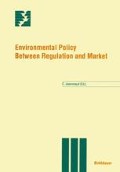Abstract
Environmental policy can be implemented through various forms of cooperation, the most elegant way being self-regulation where industry organizes itself on a voluntary basis to achieve a given environmental goal. These voluntary agreements seek to anticipate upcoming regulation by voluntary action. If the preconditions for self-regulation in industry are not met — in most cases because of free-riders — there exists a specific form of cooperation called “covenants”. These consist of contracts which are concluded between government and industry within the framework of civil law. The Netherlands already have broad experience with this form of cooperation as far as environmental policy is concerned (see Hafkamp in this volume). The government sets goals for specific target groups or sectors in such a way as to ensure that the targets stipulated in the law are met. Industry is entirely free to choose the ways and means for achieving these goals.
Access this chapter
Tax calculation will be finalised at checkout
Purchases are for personal use only
Preview
Unable to display preview. Download preview PDF.
References
Brugger, E. A.; Steib, S. (1992) Umweltpolitik aus unternehmerischer Sicht, Bundesamt für Konjunkturfragen, Bern.
CEPS, Centre for European Policy Studies (1993) Economic Instruments in EC Environmental Policy, Working Paper Report Nr. 8, Brussels.
Frey, R. L.et al. (1991) Mit Ökonomie zur Ökologie—Analysen und Lösungen des Umweltproblems aus ökonomischer Sicht, Helbling & Lichtenhahn, Basel.
Juen, C.et alii (1992) Politique de l’environnement conforme ä la logique de marché. SDES, Genève.
Koeman, N. (1993) Bilateral Agreements between Governments and Industry in Dutch Environmental Law, in: European Environmental Law Review, July.
North, D. C. (1992) Institutionen, institutioneller Wandel und Wirtschaftsleistungen, J.C.B. Mohr (Paul Siebeck), Tübingen.
Tomer, J. (1992) The Human Firm in the Natural Environment: a Socio-economic Analysis of its Behaviour, in: Ecological Economics 6, Amsterdam.
Concerning Swiss legislation:
BUNDESGESETZ UEBER DEN UMWELTSCHUTZ (1983) Stand 1. Januar 1993.
BUNDESRAT (1979) Botschaft zu einem Bundesgesetz über den Umweltschutz, 31. Oktober, Bern.
BUNDESRAT (1993) Botschaft zu einer Änderung des Bundesgesetzes über den Umweltschutz, 7. Juni, Bern.
NATIONALRAT (1994) Die Kohärenz staatlicher Aktivitäten: das Beispiel des Vollzugs der Luftreinhaltepolitik; Inspektionsbericht der Geschäftsprüfungskommission des Nationalrates zuhanden des Bundesrates, 5. Mai, Bern.
STÄNDERAT (1994) Umweltschutzgesetz-Änderung; Entwurf des Bundesrates/ Anträge der Kommission Umwelt, Raumplanung und Energie des Ständerates, Bern.
Concerning the case study:
INFRACONSULT (1992) Strukturelle Effekte von Umweltregelungen am Beispiel der Lack–und Farbenfabrikanten, Bundesamt für Konjunkturfragen, Bern.
KEL-CH (1986) Gemeinsame Erklärung zuhanden des Bundesamtes für Umweltschutz betreffend die Reduktion organischer Lösemittel bei der Herstellung und Verwendung von Anstrichstoffenund Hilfsmitteln dazu, Zürich.
KEL-CH (1993) Reglement für die Vergabe von KEL-CH-Zeichen für lösemittelfreie—und lösemittelarme Anstrichstoffe, Zürich.
Author information
Authors and Affiliations
Editor information
Editors and Affiliations
Rights and permissions
Copyright information
© 1997 Birkhäuser Verlag Basel/Switzerland
About this chapter
Cite this chapter
Brugger, E.A., Gorsler, B. (1997). Covenants as Central Elements in an Effective Environmental Policy Mix. In: Jeanrenaud, C. (eds) Environmental Policy Between Regulation and Market. Themenhefte Schwerpunktprogramm Umwelt. Birkhäuser Basel. https://doi.org/10.1007/978-3-0348-9012-0_13
Download citation
DOI: https://doi.org/10.1007/978-3-0348-9012-0_13
Publisher Name: Birkhäuser Basel
Print ISBN: 978-3-7643-5319-3
Online ISBN: 978-3-0348-9012-0
eBook Packages: Springer Book Archive

